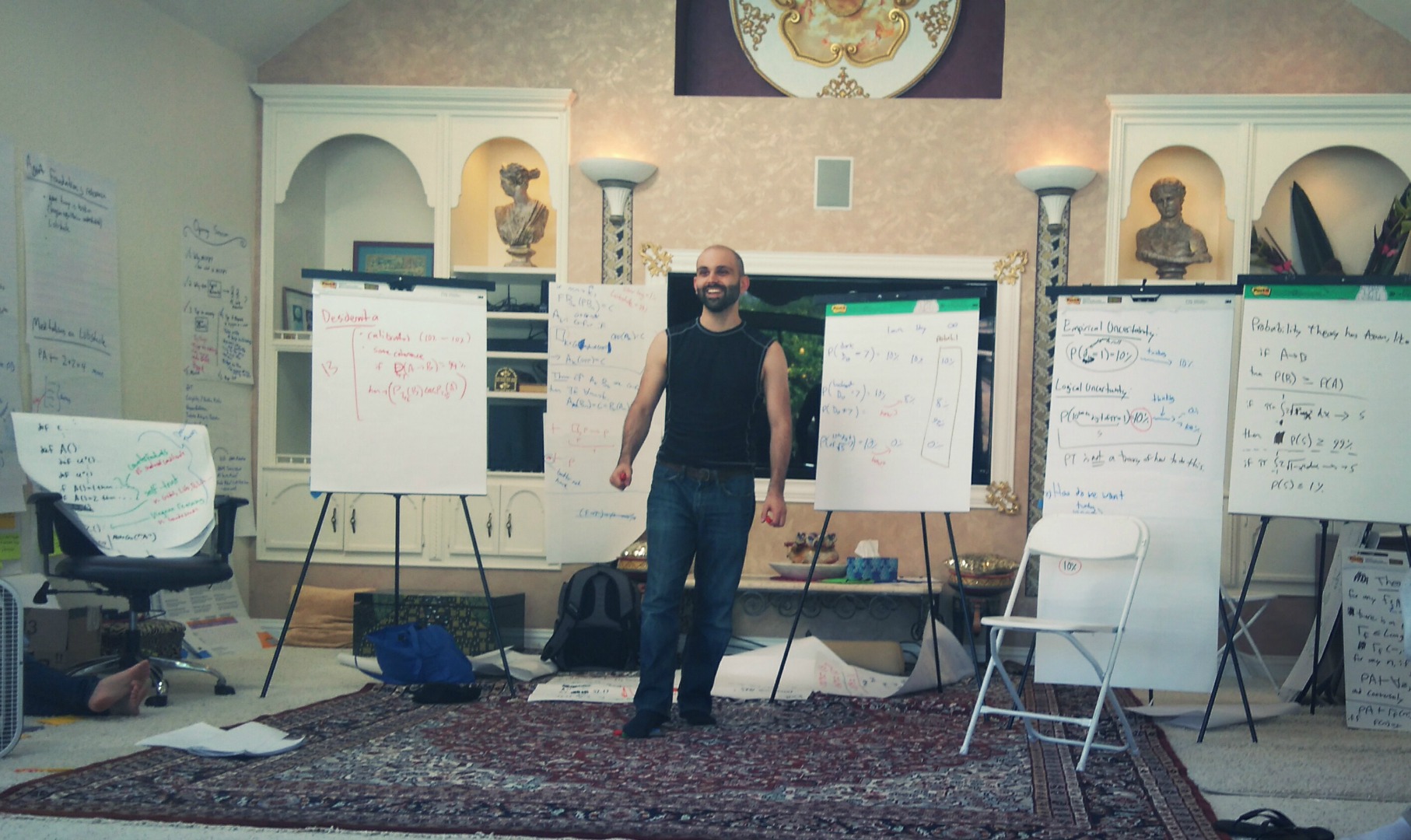2018-Jan-17
Envelope paradox
Problem:
You are given two blank envelopes which each contain money.
One envelope contains twice as much as the other.
You may choose an envelope and keep the money it contains.
After choosing, you have the option to switch for the other envelope.
Should you switch?
Pitfall:
Clearly there is no reason to switch (or not to switch) since the envelopes are
blank and at no point do you learn anything new about their contents.
However, the following argument seems to show you actually should switch.
Let \(X\) be the amount of money in the envelope chosen originally.
The other envelope contains an amount of either \(2X\) or \(X/2\), each with
probability \(1/2\).
Thus the expected value of the other envelope is
\[\frac{1}{2} (2X) + \frac{1}{2} (X/2) = \frac{5}{4} X > X.\]
…so you should switch?
Solution:
Whenever things get tricky, it’s best to be as formal and methodical as
possible.
What do we actually mean by \(X\)?
We’re taking \(X\) to be the amount of money in the envelope we choose
originally.
That means \(X\) is a random variable whose value depends on the random choice
of the original envelope.
It’s true that \(X\) is equally likely to be either the smaller or larger amount.
Let these be \(x\) and \(2x\).
Then we need to find the expected value of the other envelope.
Let the value of the other envelope be \(X'\).
Implicitly we are finding the expected value of \(X'\) by conditioning
on the value of \(X\).
There are two possibilities, and in each case we know what we get:
\[\begin{align*}
\mathbb{E}(X') &= \mathbb{P}(X' > X)\mathbb{E}(X' | X' > X)
+ \mathbb{P}(X' < X)\mathbb{E}(X' | X' < X) \\
&= \frac{1}{2}\mathbb{E}(X' | X' > X)
+ \frac{1}{2}\mathbb{E}(X' | X' < X)
\end{align*}\]
Note that depending on whether \(X' > X\) or \(X' < X\) the value of \(X\) is
different.
If \(X' > X\), then \(X = x\) and \(X' = 2X = 2x\), and if \(X' < X\), then \(X = 2x\)
and \(X' = X/2 = x\).
So,
\[\begin{align*}
\frac{1}{2}\mathbb{E}(X' | X' > X) + \frac{1}{2}\mathbb{E}(X' | X' < X)
&= \frac{1}{2}\mathbb{E}(X' | X'=2X) \\
&\qquad {} + \frac{1}{2}\mathbb{E}(X' | X'=X/2) \\
&= \frac{1}{2}2x + \frac{1}{2}x \\
&= \frac{3}{2}x \\
&= \mathbb{E}(X).
\end{align*}\]
Comparing with the pitfall solution, the key difference is that we cannot
use the same symbol \(X\) in two cases if our assumption about the value of
\(X\) is different in each case.
Tricky!
Monty Hall problem
Problem:
In the TV game show Let’s Make a Deal, you get to win a prize by opening
one of three doors.
Behind one door is a car and behind the others are goats.
You pick a door, say #1, and without opening #1 the host Monty Hall
intentionally shows you that a goat is behind another door, say
#3, and gives you the chance to change to #2.
Should you change doors?
Pitfall:
You have the choice between two doors, one with a car, the other with a goat.
Reasoning by symmetry, the probability of each configuration is \(1/2\), so there
is no point switching.
Solution:
It’s true that we know there are two possible configurations at this point,
but that’s not all we know.
We also know that #2 was not a door chosen by Monty as a door with a goat.
This gives us an extra clue that #2 might have the car.
Again, the best way to deal with tricky problems is being as rigorous
as possible.
Let’s explicitly set up a probability model as follows.
Let \(C \in \{1,2,3\}\) be the random variable for the door with the car.
Let \(S_3\) be the event that Monty chooses #3 to show a goat.
Then we can write down the following conditional probabilities.
\[\begin{align*}
\mathbb{P}(S_3|C=1)&=\frac{1}{2} \\
\mathbb{P}(S_3|C=2)&=1 \\
\mathbb{P}(S_3|C=3)&=0.
\end{align*}\]
These are all we need to compute \(\mathbb{P}(C=2|S_3)\), which is the probability
of winning if we switch.
Using Bayes’s rule, we have
\[\begin{align*}
\mathbb{P}(C=2|S_3)
&= \frac{\mathbb{P}(S_3|C=2)\mathbb{P}(C=2)}{\mathbb{P}(S_3)} \\
&=\frac{\mathbb{P}(S_3|C=2)\mathbb{P}(C=2)}{
\sum_{i=1}^3 \mathbb{P}(S_3|C=i)\mathbb{P}(C=i)} \\
&=\frac{\mathbb{P}(S_3|C=2)}{
\mathbb{P}(S_3|C=1)+\mathbb{P}(S_3|C=2)+\mathbb{P}(S_3|C=3)} \\
&=\frac{1}{\frac12+1+0} =\frac23 > \frac{1}{2}.
\end{align*}\]
Feminist bank teller question
Problem:
Linda is 31 years old, single, outspoken, and very bright.
She majored in philosophy.
As a student, she was deeply concerned with issues of discrimination and
social justice, and also participated in anti-nuclear demonstrations.
Which is more probable?
- Linda is a bank teller.
- Linda is a bank teller and is active in the feminist movement.
Pitfall:
The description makes it very plausible that Linda is active in the feminist
movement, therefore #2 is more likely than #1.
Solution:
This is an example of the conjunction fallacy.
Let \(B\) be the event Linda is a bank teller, and let \(F\) be the event that
Linda is active in the feminist movement.
Then we can immediately say \(\mathbb{P}(B) \geq \mathbb{P}(F \cap B)\)
since \(F \cap B \subseteq B\).
And so #2 cannot be more probable than #1.
In general, if more details are added, we cannot become more confident in a
claim.
This goes against a bias we have to consider situations more plausible if
they are specific and vivid.
For more on cognitive biases and heuristics, see
Thinking, Fast and Slow,
but also see
the mistakes in that book caused by cognitive biases and heuristics.
Base rate neglect
Problem:
A certain disease affects 1 in 1000 people.
A medical diagnostic test for the disease has 95% accuracy, i.e.
95% of the time it gives the correct diagnosis (whether you’re diseased
or not).
Suppose you take the test and it reads positive, what is the probability
that you have the disease?
Pitfall:
Since the diagnostic has 95% accuracy, then in my case I can conclude that
the probability I have the disease is 95%.
Solution:
Let \(D\) be the event I have the disease, and let \(P\) be the event I receive
a positive diagnosis.
We seek \(\mathbb{P}(D|P)\).
Bayes’s rule gives
\[\begin{align*}
\mathbb{P}(D|P) &= \frac{\mathbb{P}(P|D)\mathbb{P}(D)}{\mathbb{P}(P)} \\
&= \frac{\mathbb{P}(P|D)\mathbb{P}(D)}{\mathbb{P}(P|D)\mathbb{P}(D)
+ \mathbb{P}(P|\neg D)\mathbb{P}(\neg D)} \\
&= \frac{(0.95)(0.001)}{(0.95)(0.001)
+ (0.05)(0.999)} \\
&= 0.019 = 1.9\%.
\end{align*}\]
So the probability I have the disease is actually very small, even though
I got a positive test.
This is another case of not using all the information we have.
The 95% accuracy needs to be combined with the very low probability that
anyone has the disease.
Problems of this type have been given to doctors and medical students who
often fail to find the solution.
Birthday paradox
Problem:
In a group of 23 people, what is the probability that at least 2 of them
have the same birthday?
Pitfall:
The probability must be small since there are only 23 people and 365 possible
birthdays.
Solution:
Let \(N\) be the event no 2 people have the same birthday.
The total number of assignments from people to birthdays is
\(365^{23}\).
The total number of assignments from people to birthdays with no repeats
is \(365 \cdot 364 \cdot \,\cdots\, \cdot 343\) since
there are 365 possibilities for the first person’s birthday, which leaves
364 possibilities for the next, and so on.
But
\[\mathbb{P}(N) = \frac{365^{23}}{365 \cdot 364 \cdot\, \cdots\, \cdot 343} = 0.492703.\]
Then the probability that 2 people share a birthday is \(1-0.492703=0.507297\).
So the probability isn’t small; in fact it’s greater than \(1/2\)!
It’s true that any given pair of people are unlikely to share a birthday,
but as the size of the group grows, the probability that all pairs do not
share a birthday becomes small.
There are \(\binom{23}{2} = 253\) different pairs of people in a group of 23.
2017-Oct-10
Usually when we talk about probabilities, we have certain given information,
which takes the form of a \(\sigma\)-algebra of possible events, and there is
also a probability function that assigns values to each event.
The rationality of a probability function is judged based on the relationships
between events.
For example if \(A \subseteq B\) then we must have \(P(A) \leq P(B)\).
But as long as these relationships are satisfied (giving a proper probability
measure), the probabilities could be anything.
As such, we do not judge subjective probabilities based on whether they’re
actually accurate or not, just whether they are consistent with each other.
Now, imagine if information isn’t the limiting factor in our uncertainty,
but rather it’s our lack of mathematical knowledge.
A statement like the Riemann Hypothesis (RH) is unknown even though it is
entirely determined by the axiom system we use, leaving aside issues of
completeness.
Here there’s no given \(\sigma\)-algebra and in fact the relationships
between RH and other statements may themselves be difficult to determine.
A more realistic view is that we have limited computational resources, we want
to solve an intractible problem, and we’ll settle for the best approximation we
can get.
Thus a probability function is seen as a kind of approximation algorithm.
With this algorithmic language, however, we aren’t able to give a very good
answer for single propositions like RH.
If RH is the entire set of inputs, the optimal approximation is the exact
truth value, because it takes a trivial amount of computational resources to
output the constant 1 or 0.
If the set of inputs is infinite, then the particular input corresponding to
RH makes no difference in an asymptotic analysis.
For more elaboration on this theme, see this
paper.
In traditional Bayesianism there is a seemingly ineradicable source of
subjectivity from the choice of prefix Turing machine used to define
Solomonoff’s prior.
Any one input can be assigned a wide range of probabilities.
Perhaps we are left with an analogous but different kind of subjectivity for
mathematical probabilities.
 (Above: Andrew Critch thinking about this in Berkeley.)
(Above: Andrew Critch thinking about this in Berkeley.)
2017-Jun-28
The 700MHz (2014) and 2500MHz (2015) spectrum auctions generated revenues of
5,270,636,002 CAD from 302 licenses and 755,371,001 CAD from 97 licenses.
Both
auctions used a combinatorial clock auction (CCA) format involving an
ascending clock phase followed by a sealed-bid supplementary stage where
bids could be made on packages of products.
Final prices were determined
using Vickrey pricing with a core-adjustment. An activity
rule was used which required bidders to make bids or lose eligibility to
bid in later clock rounds, along with a revealed preference rule which
allows the eligibility limit to be exceeded as long as consistency
checks are satisfied. For full details on the auction formats see the
official documentation
(700MHz rules,
700MHz additional details,
2500MHz rules);
and the record of bids placed is here
for 700MHz and
here
for 2500MHz.
Bid consistency
The revealed preference rule prevents some inconsistent behavior but not all.
By “truthful”, we mean bids that are true indications of subjective value,
and by “consistent” we mean bids that are indications of some fixed set of
valuations, possibly not the bidder’s actual valuations.
The following table gives the values of Afriat’s critical cost
efficiency index (CCEI) for the 700MHz auction. Recall
that for a CCEI value \(x\), if \(x < 1\) there is at least some
intransitivity in preferences (i.e. inconsistent bidding) and \(1-x\) can be
interpreted as the fraction of expenditure wasted making inefficient
choices (see this
by S. Kariv for more).
| Bidder |
CCEI (clock rounds) |
CCEI (clock and supp. rounds) |
| Bell |
0.930 |
0.417 |
| Bragg |
0.880 |
0.420 |
| Feenix |
1 |
1 |
| MTS |
0.996 |
0.627 |
| Novus |
1 |
1 |
| Rogers |
0.998 |
0.742 |
| SaskTel |
1 |
1 |
| TBayTel |
1 |
1 |
| Telus |
0.970 |
0.488 |
| Videotron |
0.879 |
0.560 |
Kroemer et al.
conclude for the 700MHz auction, “the
numbers suggest that bidders deviated substantially from straightforward
bidding” in the clock rounds. But “it is not unreasonable to believe
that bidders tried to bid up to their true valuation in the
supplementary stage” because of higher bid amounts compared to the clock
rounds.
The next table gives CCEI values for the 2500MHz
auction. We extend the definition of CCEI to apply to supplementary bids
as in Kroemer’s paper.
| Bidder |
CCEI (clock rounds) |
CCEI (clock and supp. rounds) |
| Bell |
0.913 |
0.712 |
| Bragg |
0.920 |
0.530 |
| Corridor |
1 |
1 |
| MTS |
1 |
1 |
| Rogers |
1 |
1 |
| SSi Micro |
1 |
1 |
| TBayTel |
1 |
1 |
| Telus |
0.997 |
0.996 |
| Videotron |
1 |
1 |
| WIND |
1 |
1 |
| Xplornet |
1 |
0.578 |
Kroemer et al. (Sec. 5.2) also point out that the
total number of bids submitted in the 700MHz auction was much smaller
than the number of possible bids, which probably indicates untruthful
bidding since an omitted
package must have valuation less than or equal to its (low) opening price.
The same observation holds for the 2500MHz auction. More exactly, the
auction formats enforced a limit on the number of packages bidders were
allowed to submit, which was in the hundreds, and bidders generally did
not reach the limit.
Ideally, we would determine whether the bids made are consistent with a
non-truthful strategy incorporating gaming and/or coordination.
The papers
Janssen and Karamychev -
“Raising Rivals’ Cost in Multi-unit Auctions”
and
Janssen and Kasberger -
“On the Clock of the Combinatorial Auction”
derive Bayesian Nash equilibria under gaming preferences and conclude that
GARP is not violated in equilibrium gaming strategies.
We note that the assumptions in these game models do not include all features
of the CCAs under consideration e.g.
discrete products, many bidders, public aggregate excess
demand, revealed preference rule, initial EP limit,
supplementary package limit, 50% mid-auction deposits.
Bids, budgets, and final prices
Bidders may have a notion of a budget – the maximum they are willing to
spend. But how should this correspond to the maximum they should bid? In
general, bidders may end up paying the exact amount of their highest
bid, but looking at the data we see bid prices and final prices can be
very different in practice.
The following tables show figures from both auctions that illustrate this
difference.
All prices are given in CAD.
700MHz auction: highest bid placed.
Average ratio: 0.192. Max ratio: 0.766.
| Bidder |
Max bid (\(M\)) |
Allocation stage final price (\(p\)) |
Ratio (\(p/M\)) |
Final clock bid |
| Bell |
3,999,999,000 |
565,705,517 |
0.141 |
1,366,867,000 |
| Bragg |
141,894,000 |
20,298,000 |
0.143 |
38,814,000 |
| Feenix |
60,650,000 |
284,000 |
0.005 |
346,000 |
| MTS |
73,067,000 |
8,772,072 |
0.120 |
10,853,000 |
| Novus |
112,359,000 |
0 |
0 |
0 |
| Rogers |
4,299,949,000 |
3,291,738,000 |
0.766 |
3,931,268,000 |
| Sasktel |
75,000,000 |
7,556,929 |
0.101 |
11,927,000 |
| TbayTel |
7,683,000 |
0 |
0 |
0 |
| Telus |
3,750,000,000 |
1,142,953,484 |
0.305 |
1,313,035,000 |
| Videotron |
677,524,000 |
233,328,000 |
0.344 |
468,530,000 |
700MHz auction: (highest) bid placed on package eventually won.
Average ratio: 0.447. Max ratio: 0.766.
| Bidder |
Max bid on won package (\(W\)) |
Allocation stage final price (\(p\)) |
Ratio (\(p/W\)) |
Allocation stage Vickrey price |
| Bell |
2,583,868,000 |
565,705,517 |
0.219 |
565,705,000 |
| Bragg |
51,000,000 |
20,298,000 |
0.398 |
20,298,000 |
| Feenix |
425,000 |
284,000 |
0.668 |
284,000 |
| MTS |
40,000,000 |
8,772,072 |
0.219 |
3,198,000 |
| Novus |
N/A |
0 |
N/A |
0 |
| Rogers |
4,299,949,000 |
3,291,738,000 |
0.766 |
3,291,738,000 |
| Sasktel |
62,400,000 |
7,556,929 |
0.121 |
2,755,000 |
| TbayTel |
N/A |
0 |
N/A |
0 |
| Telus |
1,607,300,000 |
1,142,953,484 |
0.711 |
1,142,953,000 |
| Videotron |
490,000,000 |
233,328,000 |
0.476 |
233,328,000 |
2500MHz auction: highest bid placed.
Average ratio: 0.135. Max ratio: 0.277.
| Bidder |
Max bid (\(M\)) |
Allocation stage final price (\(p\)) |
Ratio (\(p/M\)) |
Final clock bid |
| Bell |
542,746,000 |
28,730,000 |
0.053 |
76,214,000 |
| Bragg |
35,935,000 |
4,821,021 |
0.134 |
12,091,000 |
| Corridor |
9,300,000 |
2,299,000 |
0.247 |
N/A |
| MTS |
13,609,000 |
2,242,000 |
0.165 |
2,609,000 |
| Rogers |
304,109,000 |
24,049,546 |
0.079 |
52,343,000 |
| SSi Micro |
851,000 |
0 |
0 |
0 |
| TBayTel |
12,001,000 |
1,731,000 |
0.144 |
1,731,000 |
| Telus |
1,771,723,000 |
478,819,000 |
0.270 |
1,038,472,000 |
| Videotron |
749,128,000 |
66,552,980 |
0.089 |
231,851,000 |
| WIND |
22,609,000 |
0 |
0 |
0 |
| Xplornet |
91,974,000 |
25,472,454 |
0.277 |
57,839,000 |
2500MHz auction: (highest) bid placed on package eventually won.
Average ratio: 0.235. Max ratio: 0.410.
| Bidder |
Max bid on won package (\(W\)) |
Allocation stage final price (\(p\)) |
Ratio (\(p/W\)) |
Allocation stage Vickrey price |
| Bell |
536,563,000 |
28,730,000 |
0.054 |
28,730,000 |
| Bragg |
19,000,000 |
4,821,021 |
0.254 |
3,536,000 |
| Corridor |
6,440,000 |
2,299,000 |
0.357 |
2,299,000 |
| MTS |
11,000,000 |
2,242,000 |
0.204 |
2,242,000 |
| Rogers |
OR |
24,049,546 |
N/A |
21,252,000 |
| SSi Micro |
N/A |
0 |
N/A |
0 |
| TBayTel |
12,001,000 |
1,731,000 |
0.144 |
1,731,000 |
| Telus |
1,771,723,000 |
478,819,000 |
0.270 |
478,819,000 |
| Videotron |
358,477,000 |
66,552,980 |
0.186 |
61,092,000 |
| WIND |
N/A |
0 |
N/A |
0 |
| Xplornet |
62,200,000 |
25,472,454 |
0.410 |
22,917,000 |
Across both auctions, we see that bidders paid an average of 16% of
their maximum bid placed, where each bidder is equally weighted.
Misc. notes
Researchers design approximation algorithms for winner and price
determination in auctions (in e.g. this paper)
because exact
optimization can be intractable as the number of bids grows, at least in
the worst case. However, in these recent auction instances, theoretical
intractability did not present a problem because the solution was
computable in a small amount of time.
The 2500MHz allocation stage involved 2,239 bids and a
GLPK-powered solver finds the winners and final prices in a couple
minutes on a standard computer.
Simulations involving well over 30,000 random bids still take a feasible amount
of time.
In the 2500MHz auction, there were 4 pairs of package submissions where
the lower-priced package had strictly higher quantities of products.
In this case the lower-priced package is superfluous.
This table shows the packages, submitted by Bell.
| |
Price of larger package (CAD) |
Price of smaller package (CAD) |
Number of products difference |
| 1 |
535,917,000 |
536,214,000 |
3 |
| 2 |
536,628,000 |
536,645,000 |
3 |
| 3 |
536,401,000 |
536,545,000 |
3 |
| 4 |
536,434,000 |
536,563,000 |
3 |
Acknowledgement: Thanks to Z. Gao for pointers.

 (Above: Andrew Critch thinking about this in Berkeley.)
(Above: Andrew Critch thinking about this in Berkeley.)



